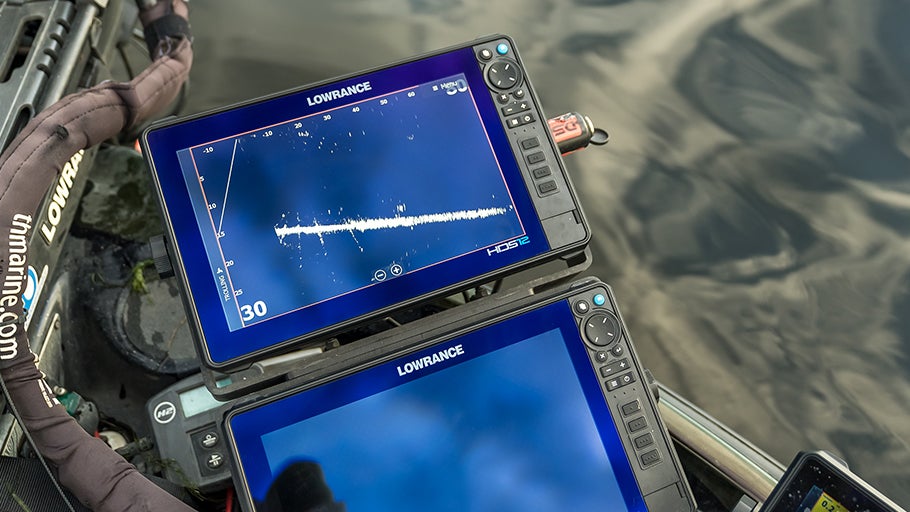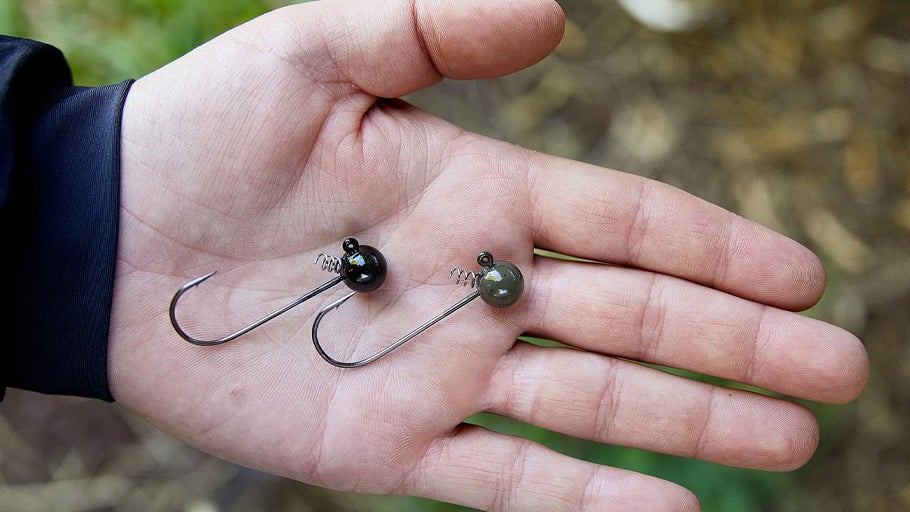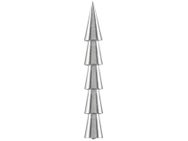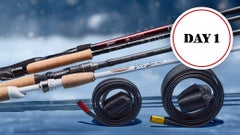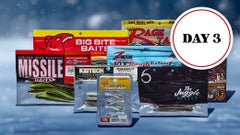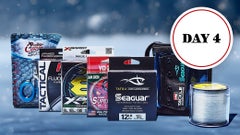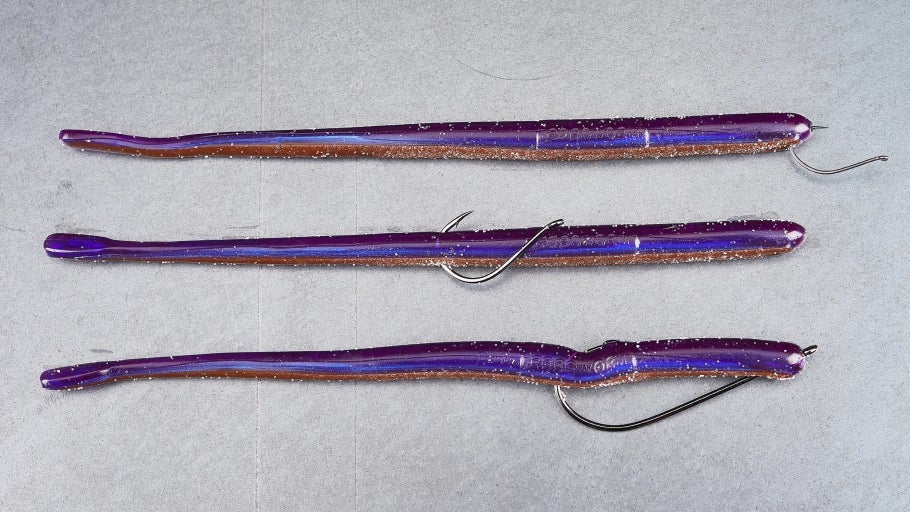
Neko Rig Gear Guide
Typically consisting of a soft stickbait or straight-tail worm rigged with an O-ring, hook, and nail weight in one end, the Neko rig is an incredibly dependable technique anytime bass are oriented towards the bottom. Whether you prefer to call it "neck-oh" or "neek-oh," this workhorse finesse technique was imported from Japan in the late 90's and quickly gained traction on the professional tournament trails. Even though it hasn't been around quite as long as the shakey head or the Texas rig, the Neko rig's lightly weighted presentation delivers the same wide-reaching dependability as these bass fishing staples.
The Neko rig is a versatile setup that can be used 12 months of the year in varying depths. In deeper open waters, it can be fished on main lake points, ledges, and grass lines, and also works well for suspended bass. Up shallow, the Neko rig has a similarly wide variety of applications, and it can even be skipped underneath docks.
Parts of a Neko Rig
Neko Rig Soft Baits
The two most commonly used baits for neko rigs are stickbaits and straight tail worms, however, this incredible versatile technique can be utilized with a wide range of soft plastic baits. Don't hesitate neko-rigging other baits, like craws, creature, or even flukes anytime bass are oriented towards the bottom and looking for an easy meal.
Neko Rig O-Ring
To help reinforce the connection between the hook and the soft bait anglers will slide an O-ring or a band around the bait. This boosts the anchorage of the hook, preventing it from from ripping/falling out on while casting or moving through snaggy terrain.
Neko Rig Hooks
A typical Neko hook will have a smooth, straight shank in a long or short length, while some styles are designed with weedguards for fishing around cover. Proper hook sizes often run in the 1/0–2 size range. Whether or not you’re using an O-ring also comes into play when selecting the proper hook size.
Neko Rig Weights
Neko rig weights come in a variety of sizes, styles, and compositions, but your "standard" nail weight is going to characterized by a slim, straight construction with ridges along the sides that allow for firm, easy insertion into the body of the bait. While neko rig weights might be slighltly different, they all serve the same general purpose, which is to orient the bait "nose-down" so it can make contact with the bottom.
Neko Rig Rods
Rod selection for Neko rigs is pretty straightforward, and there’s a good chance you already own a rod that will work great. Both spinning and casting rods can be successfully used, but just like with most light worm-fishing applications, spinning rods tend to be preferred.
Depending on the size of the bait and amount of weight added, a well-rounded Neko rod will be made of graphite and typically have a medium-light to a medium power. As far as length goes, rods in the 6’6"–7’6” range will get the job done well, with those measuring 6’8”–7’2” being the real sweet spot in terms of line control, hook-setting ability, and accuracy. For rod taper, look no further than an extra-fast or fast action action.
Neko Rig Reels
Spinning reel choice is more a matter of personal preference than anything else. While a 2500-size reel is a phenomenal starting point, some anglers may prefer a larger reel as the increased spool diameter provides more inches per turn, which translates to a faster retrieve. Besides enabling you to bring your bait in more rapidly when it's time for another cast, a faster retrieve also allows you to pick up slack line faster for a more positive hook set.
Despite spinning reels being the most popular choices for Neko rigs, casting reels can also be successfully used. BFS reels are particularly good in this category, and selecting a high-speed model with an 8.1:1 or faster ratio can be especially beneficial for the same reasons just listed above.
Neko Rig Line
Although a Neko rig is very productive on suspended bass, it’s typically fished on the bottom by dragging, hopping, or shaking. Choosing a thin-diameter, low-stretch line helps keep you stay “connected” to your bait and improves the overall sensitivity, enhancing bottom feel and detection of light bites.
Braided line has little to no stretch and extremely thin diameter for its strength, making it a top pick for finesse tactics like Neko rigs. Braids from 10–20lb work great, with those in the lower half of that range being most commonly used. Be sure to add a 6–12lb fluorocarbon leader in a 3+ foot length for a more natural presentation.
Fluorocarbon is an excellent choice for a Neko rig since it sinks, is harder to see underwater, and stretches less than standard monofilament. Being that Neko rigs fall into the finesse category and are typically fished on light lines, look for fluorocarbon lines in the 6–12lb range for added stealth and a faster sink rate with less line drag.
Neko Rig Rigging
Choosing a Neko Rig Weight
Nail weights used for Neko-rigging come in a wide array of sizes, shapes, attachment styles, and compositions. While preference will largely be dictated by the angler, there are a couple of guiding principles when it comes to choosing the correct weight.
Picking the Right Weight Size for Neko Rigging
Weight largely depends on the depth you're fishing and the desired sink rate, with Neko weights typically ranging from 1/32–1/8 ounce. Generally speaking, the deeper you are fishing, the heavier weight you will need to maintain contact with the bottom. With that said, it is often best practice to try and utilize the lightest weight you can effectively fish, especially to prevent snagging in shallow water. However, too light of a weight can cause your bait to drift around too much or not stand up properly, so just make sure you are maintaining contact with the bottom.
Another consideration when choosing which size of neko weight you want to use is the sink rate. A lightly weighted Neko-rigged bait may spiral and undulate as it sinks, prompting strikes from fish if they are suspending throughout the water column. If fish are locked to the bottom, a heaveir neko rig weight will allow you to get to bottom quickly and target fish more effectively.
Tungsten vs. Lead
Lead and tungsten weights are available for Neko rigs, with the latter being priced higher, but offering a more compact size and more density for a faster sink rate in contrast to a comparable lead weight.
Nail vs. Half Moon
Standard nail weights are characterized by a slim, straight construction with ridges along the sides that allow for full insertion with very little, if any, of the weight being exposed. Neko weights with a half-moon or mushroom shape on one end are meant to be exposed for increased sensitivity and sound when directly contacting the lake floor, especially when fishing hard bottom.
Picking the Right Hook
A typical Neko hook will have a smooth, straight shank in a long or short length, while some styles are designed with weedguards for fishing around cover. Proper hook sizes often run in the 1/0–2 size range. Whether or not you’re using an O-ring also comes into play when selecting the proper hook size.
O-Rings for Neko Rigs
Setting up a Neko rig usually involves running the hook through the bait directly inline or using an O-ring. Baits made from ElaZtech are excellent choices for directly hooking a bait because this material is incredibly durable and can be thinly skin-hooked to maximize hook exposure. However, the most popular method involves slipping the bait into a rubber O-ring, then sliding a hook under the ring. While hooking directly through the bait’s plastic may reduce the exposed hook gap and require a slight increase in size for optimal hookups, rigging with an O-ring leaves a lot of gap exposed with less damage to the bait. Various tools are on the market to help speed up the rigging process while using O-rings.
Whether running a hook directly through your bait or using an O-ring, you want the hook placement to be biased more towards the “front” of the bait where the weight is inserted.
When directly hooking the bait inline or using an O-ring, start by inserting the hook point facing towards the end of the bait that’s opposite the weight. After the hook is fully threaded on, the point will be facing away from the bait. While fishing, this will make the hook ride with the point on top which will help consistently hook the fish in the upper part of the mouth.
Neko Rig Tips and Tricks
Neko rigs can also be rigged weedless for fishing around thicker cover. A selection of hooks are available that either include weedguards or are specially designed to allow for texposing. The following video shows one method of rigging a weedless Neko rig using the popular Gamakatsu G-Finesse Cover Neko Hook along with an exposed screw-in weight.
For added flash and vibration while dragging or hopping along the bottom, a blade can be attached to the end of a worm or soft stickbait. Available from several manufacturers, this setup typically features a small willow-leaf blade that’s affixed to a screw lock that twists directly into a soft plastic bait.
To give your Neko rig a bit of sound, try using an exposed weight or leaving a short section of your nail weight sticking out of the bait. As you work the bait, the weight will directly come in contact with hard cover and structure, resulting in a touch of bass-attracting sound. Since it is harder and denser than lead, a tungsten weight is especially effective for this.
Neko Rig Colors
While incredibly lethal with straight tail worms and stickbaits, don't hesitate to also try Neko-rigging other plastics, like craws, creature baits, or even Flukes. Whatever bait you have rigged, color selection is mainly based on water clarity and available forage.
As a general starting point, look at translucent colors or muted/natural tones like watermelon and shad when fishing in the clearest water. If there’s some stain, solid colors like pb&j, dark pumpkin, baby bass, and others can work well. Dirty water can be tougher for fishing a Neko rig, but success can be had with larger, bulkier baits in solid colors like white, red shad, june bug, black and blue, and many more.
Conclusion
A great alternative to a shakey head or Texas rig, the Neko rig can work wonders when nothing else will. Perfect for targeting pressured fish that see plenty of the more “standard” presentations, the Neko offers bass a unique look and action they might not be accustomed to. Whether it’s the dead of winter or the heat of summer, the Neko rig deserves to be part of your finesse fishing strategy!

